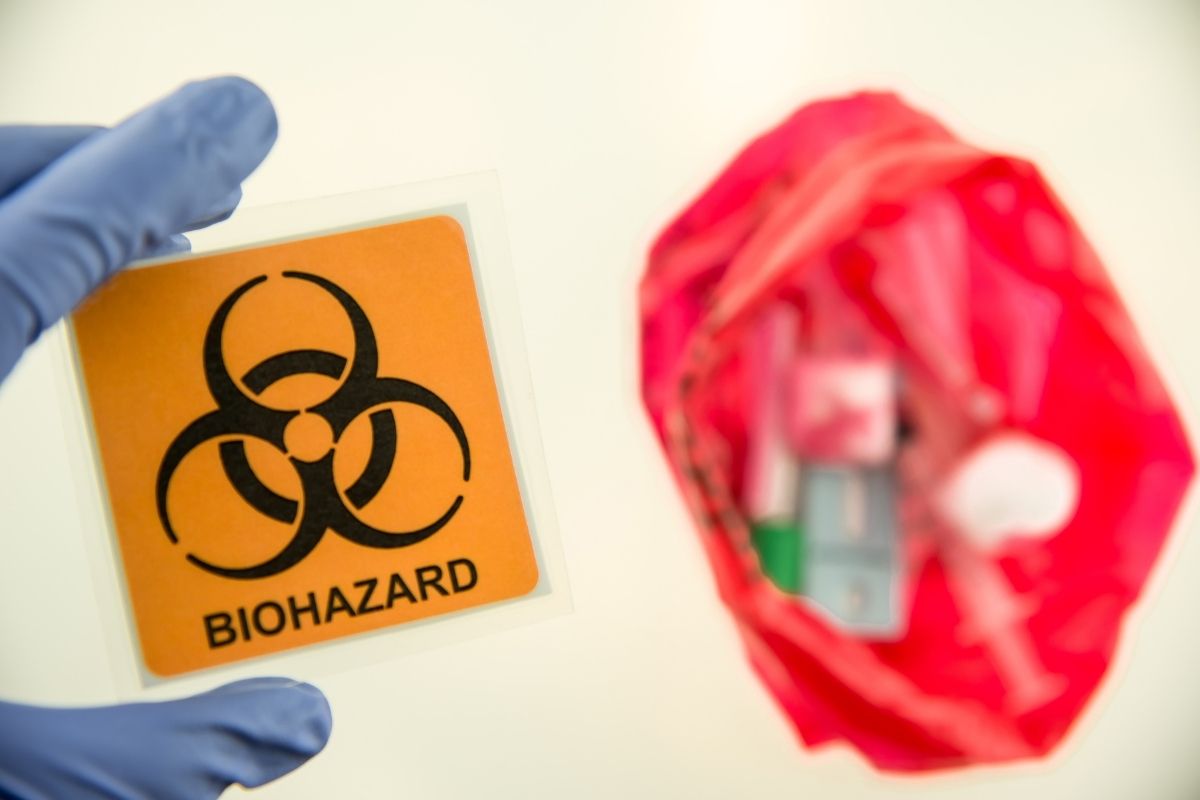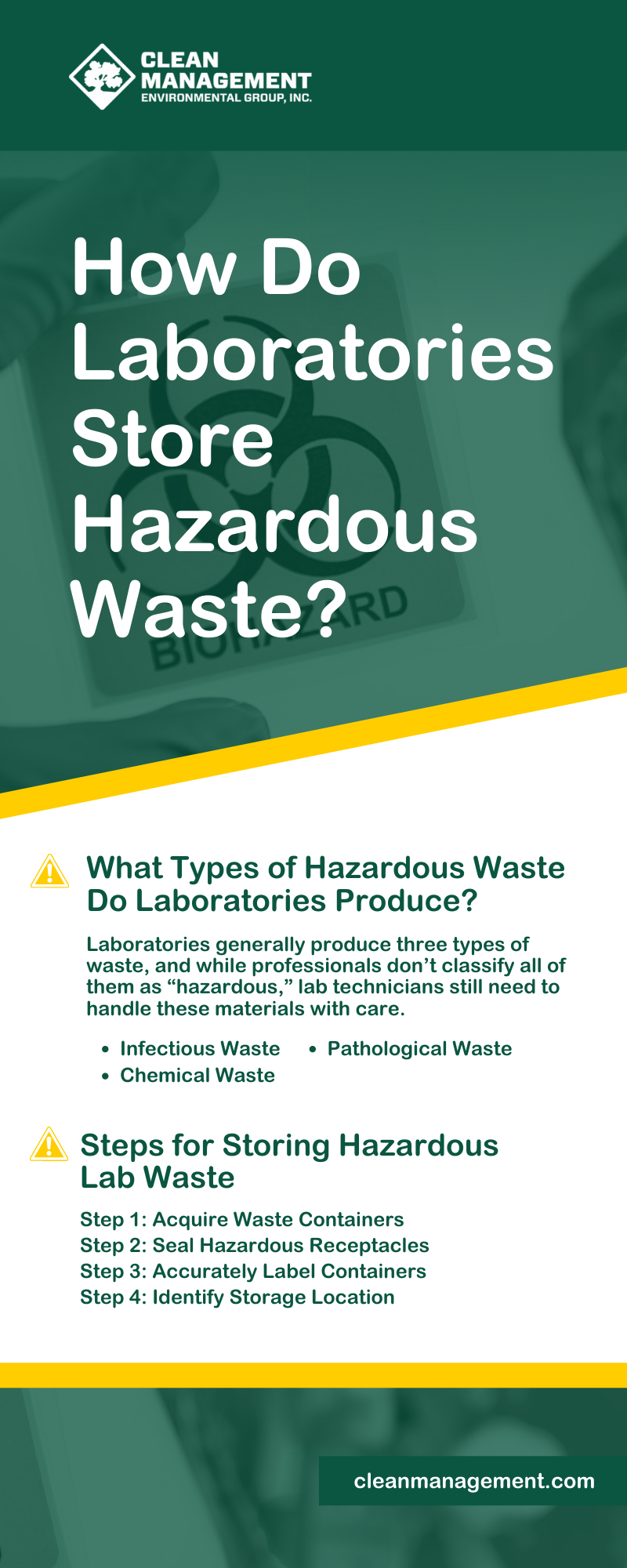How Do Laboratories Store Hazardous Waste?

Running a laboratory is no easy task. From performing experiments to maintaining complex lab equipment, these facilities operate to improve so many industries across the globe. However, working in a lab isn’t only about making discoveries and designing essential products. Managing laboratory waste requires specialized knowledge and skill to maintain safety standards.
Properly storing hazardous waste isn’t only in the name of safety; it also keeps research establishments from breaking laws and paying hefty fines for improper procedures. This process is heavily regulated to ensure the health of lab workers, disposal employees, and the environment. So, how do laboratories store hazardous waste exactly? Keep reading to learn more.
What Types of Hazardous Waste Do Laboratories Produce?
Before exploring laboratory storage processes, it’s helpful to know what kinds of waste these facilities generate. Laboratories generally produce three types of waste, and while professionals don’t classify all of them as “hazardous,” lab technicians still need to handle these materials with care.
Infectious Waste
Laboratories operating in medical settings often generate infectious waste. Also known as “red bag” waste, professionals identify this kind of material as a biohazard due to its ability to infect humans. Biohazard infectious waste might include:
- Blood and other body fluids
- Live vaccines
- Biological agents
Pathological Waste
Medical labs might also produce pathological or large tissue waste. These materials are also called “yellow bag” wastes and primarily occur in pathology and histology facilities. Pathological waste covers human and animal tissues, including organs, body parts, and carcasses. Some of these materials could potentially harm humans, so correctly storing and disposing of them is vital.
Chemical Waste
The third and most common type of waste that laboratories produce is chemical waste. All labs generate chemicals that are toxic to humans and the environment, even at low doses. Solutions, cleaning agents, and preservatives can have corrosive and other hazardous properties that put people at risk. Knowing how to store and handle these substances will keep your staff out of harm’s way.
Steps for Storing Hazardous Lab Waste
Now that you know what kinds of toxic material these facilities regularly deal with, you can better understand how laboratories store hazardous waste. Hazardous waste storage is a highly regulated process. While it may not seem like there are many steps, each stage is essential to ensuring the health and safety of anyone coming in contact with these materials.
Step 1: Acquire Waste Containers
The first thing laboratories need to do is acquire waste containers. These unique receptacles must have a lid that staff can close tightly to avoid contamination. You can’t use any old storage container to store toxic chemicals and materials; you need specialized bins, boxes, and packaging to ensure everything is up to standard.
Laboratory receptacles must meet certain criteria to satisfy federal guidelines. For example, hazardous waste containers must be in good condition, free of any wear and tear. They should also be spotless, without any leaks or lingering residue on the exterior. Your waste containers need to be appropriate for the type of materials it holds, so make sure your bins can withstand specific conditions.
Step 2: Seal Hazardous Receptacles
Sealing might be the most crucial step to storing hazardous lab waste since it puts a barrier between humans and dangerous substances. Since toxic waste is harmful to inhale, consume, or even touch, it’s imperative that lab technicians seal containers appropriately. Sealing agents like aluminum foil or plastic wrap are not appropriate lids for waste containers, as they aren’t durable enough to handle corrosive materials.
All hazardous waste containers must remain sealed at all times. Under no circumstances should lids leave receptacles, except when professionals are adding or removing waste. If you’re collecting waste from a continuous source, like drainage, you’ll need appropriate supplies like rubber stoppers and piping to create an airtight seal that prevents leakage.
Step 3: Accurately Label Containers
Labels are essential components in every laboratory. Everything in a lab has an identification tag, including hazardous waste storage locations and containers. These labels inform laboratory employees and disposal professionals about a container’s contents, so they can take the appropriate measures to protect themselves.
Hazardous waste labels must provide certain types of information to adhere to safety mandates. For example, all tags must list the name of the substance, the storage location, and the fill date. They should also include any important information that could help in the disposal process, like chemical makeup and water percentages.
Step 4: Identify Storage Location
Finally, laboratories must dedicate a space within their facility to store all of their toxic materials. This area should remain isolated from other parts of the work area to prevent cross-contamination. Be sure to have adequate signage to alert people when they are entering the storage space.
It’s important to remember to keep incompatible materials separated. Practice proper segregation methods to keep conflicting substances from coming in contact with each other at any point in the storage and disposal process. Make sure to store hazardous waste containers in secondary receptacles for added protection in the event that waste containers sustain damage.
Crucial Storage Tips
Storing hazardous laboratory waste is a detailed process, with many rules that professionals need to follow. Failure to adhere to these standards could result in a number of consequences, from fines and fees to the suspension of your facility. Consider the following tips to ensure that you’re always operating within industry standards.
Don’t Mix Materials
Mixing non-hazardous and hazardous wastes might not seem like a big deal. However, doing so will only double your amount of toxic waste, increasing disposal charges and making things more difficult for waste management professionals. It’s best to practice caution when storing hazardous waste; professionals should even keep related materials separated to avoid any missteps along the way.
Storage Has Limits
There’s a limit to how much waste you can store at your facility at one time. Besides a few exceptions, laboratories cannot hold more than 55 gallons of hazardous waste at one time. This number is lower if your facility can’t handle that much waste without causing a safety hazard. Make sure to employ a reliable waste management service to frequent your site and remove toxic materials as often as you need.
Your waste disposal team will handle your hazardous materials from there. Clean Management Environmental Group offers lab pack services to remove waste from your facility and get rid of it the right way. Contact us today to learn more about our programs so you can be confident in your laboratory’s storage and disposal methods.

